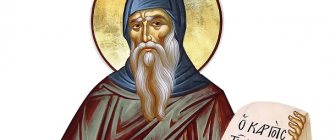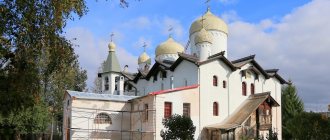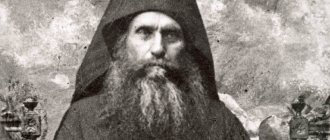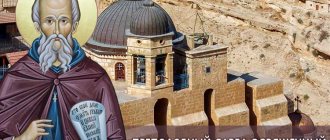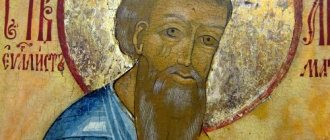Martyrs Agapia, Irene and Chionia of Aquileia. Orthodox calendar for April 29
Main church holidays, days of remembrance of saints and Orthodox shrines of today
April 29 (April 16 according to the “old style” - the church Julian calendar). Wednesday of the 2nd (Fomina) week of Easter (second week after the Holy Resurrection of Christ). Fast day . The fish is blessed at the meal . Today there is a commemoration of 14 saints known by name and a celebration in honor of two revered shrines. Next we will briefly talk about today's saints of God and holy things.
* * *
Martyrs Agapia, Irene and Chionia of Aquileia . Early Christian saints and sufferers, Christian sisters from Northern Italy, who accepted the crown of martyrdom during the tragically famous period of Diocletian's anti-Christian persecutions in 304 AD.
Having been orphaned at a young age, the holy sisters decided not to marry and led a pious lifestyle. When Emperor Diocletian visited Aquileia, he launched a severe persecution against Christians, so that soon all the prisons here were overcrowded. Then these three girls were captured and subjected to various tortures. In the service to the holy martyrs it is said that they were not afraid of the attacks of wild animals, or the cutting off of body parts, or other tortures.
During their torture, several miracles happened, but the tormentors did not come to their senses. Finally, Agapia and Chionia were burned at the stake, and Irina was pierced with arrows. The bodies of the holy martyrs were buried by Saint Anastasia , nicknamed the Pattern Maker because she eased the “bonds” - the difficulties of Christians imprisoned. These three sisters had such strong faith in God that they were not afraid of the threats of their tormentors, did not regret their youth and suffered for Christ. They gave up their corruptible life in order to receive an incorruptible life in Heaven. Now they are blissful in the Kingdom of eternal light. With their prayers, may the Lord strengthen us in Christian deeds.
* * *
Righteous Tabitha of Joppa . Saint of the 1st (Apostolic) century , known for her righteousness and miracles described in the Acts of the Apostles. the supreme apostle Peter preached near Joppa . He came to the place of the death of Saint Tabitha, prayed, knelt down, went up to the bed of the deceased and cried out: “Tabitha, arise!”, after which the righteous woman miraculously resurrected (Acts 9:36).
Righteous Tabitha of Joppa. Photo: pravoslavie.ru
Martyr Leonidas and the holy martyrs Chariessa, Nike, Galina, Kalisa (Kalida), Nunekhia, Vasilissa and Theodora . Early Christian sufferers who died at the hands of pagans in Corinth in 258 AD. The saints were thrown into the sea, but miraculously they did not drown, but walked on the water as if on dry land, singing spiritual hymns. The torturers on the ship caught up with them and drowned them, hanging heavy stones on the necks of the holy martyrs.
Martyr Leonidas. Photo: pravoslavie.ru
Transfer of the relics of the martyr Abraham of Bulgaria . The honorable remains of this Vladimir miracle worker, who died at the hands of the godless Volga Bulgarians in 1229 from the Nativity of Christ, were found and transferred to the Assumption Cathedral of the Vladimir Princess Monastery the next year after the martyrdom of the saint.
Abraham of Bulgaria. Photo: pravoslavie.ru
Icons of the Mother of God Ilyinsko-Chernigov (1658) and Tambov (1692) . Miraculous images of the Blessed Virgin Mary, revealed on this day in different years of the 17th century .
Congratulations to Orthodox Christians on the day of these shrines and the memory of all today's saints! Through their prayers, Lord, save and have mercy on us all! We are happy to congratulate those who received names in their honor through the Sacrament of Holy Baptism or monastic tonsure! As they used to say in Rus' in the old days: “For the Guardian Angels - a golden crown, and for you - good health!”
Christ is Risen!
Holy Martyr Irene of Aquileia (? (late 3rd century) - 304) - a famous early Christian, the youngest of the three sisters of Aquileia. The spiritual feat of Saint Irene lies in the fact that she died for Christ without succumbing to the threats and temptations offered. Heavenly patroness of women of her name. Memory - April 29.
The virgin was overflowing with kindnesses, you were the most beautiful Irino with suffering, you were stained with your bleeding blood, but you cast down godlessness with charm: for this reason you accepted the honors of victory, by the hand of your Creator
Kontakion of St. Irina Aquileiskaya (voice 4)
The holy martyrs Agapia, Irene and Chionia were sisters and lived near the Italian city of Aquileia. They were left orphans at a young age. The girls led pious Christian lives and rejected offers from numerous suitors. Their spiritual leader was priest Zinon. Somehow it was revealed to him in a dream that he would soon die, and the holy virgins would be taken to be tortured. The same revelation occurred to the Great Martyr Anastasia, who was in Aquileia. Having awakened, she hurried to the sisters and convinced them to courageously stand up for Christ.
Soon the prediction came true. The priest Zenon died, and the three virgins were captured and sent to trial before the emperor Diocletian. Seeing the young beautiful sisters, the emperor invited them to renounce Christ and promised to find noble suitors from his retinue. But the sisters answered that they had one groom - Christ, for their faith in Whom they were ready to suffer. By order of Diocletian, who went to Macedonia, the holy sisters were also taken there. They were handed over to the ruler Dulcytius for trial.
Icon “Martyrs of Aquileia Agapia, Irene and Chionia” (XVII century) When he saw the beauty of the girls, he was inflamed with lust for them. He took the sisters into custody on the condition that they would be released if they agreed to fulfill his wishes. But they answered that they were ready to die for their Heavenly Bridegroom - Christ. Then Dulcitius decided to take possession of them by force. When the holy sisters got up at night to pray and praised the Lord, Dulcytius crept up to the door and wanted to enter. However, an invisible force struck him, he lost his mind and rushed away. Finding no way out, the tormentor ended up on the way to the kitchen, where there were cast irons, frying pans and cauldrons, and became all dirty with soot. When he saw himself in the mirror, he thought that the sisters had bewitched him, and decided to take revenge on them. At the trial, Dulcitius ordered the holy martyrs to be naked before him. But the soldiers, no matter how hard they tried, could not do this: the clothes seemed to have grown to the bodies of the holy virgins. During the trial, Dulcitius suddenly fell asleep and no one could wake him up. But as soon as they brought him into the house, he immediately woke up. When Emperor Diocletian was informed about everything that had happened, he was angry with Dulcetius and handed the holy virgins over to judge Sisinius. He began his interrogation with his younger sister Irina. Convinced of her inflexibility, he sent her to prison and tried to force Chionia and Agapia to renounce. But it was impossible to persuade them to renounce Christ, and Sisinius ordered the burning of saints Agapia and Chionia. The sisters, having heard the verdict, thanked the Lord for the crowns of martyrdom. In the fire, Agapia and Chionia went to the Lord in prayer. When the fire went out, everyone saw that the bodies of the martyrs and their clothes were not scorched by fire, and their faces were beautiful and calm, like those of people who had fallen asleep in a quiet sleep.
The next day, Sisinius ordered St. to be brought to trial. Irina. He frightened her with the fate of her older sisters and persuaded her to renounce Christ, and then began to threaten to hand her over to be mocked in a whorehouse. But St. the martyr answered: “Let my body be given over to violent desecration, but my soul will not be desecrated by renouncing Christ.” When the soldiers of Sisinius led St. Irina in the fornication, they were caught up by two bright warriors and said: “Your master Sisiny commands you to bring the girl to a high mountain and leave there, and then come to him and report on the fulfillment of the order.” The warriors did just that. When they reported this to Sisinius, he became furious because he had not given such an order. The bright warriors were the Angels of God who saved the holy martyr from desecration. Sisinius with a detachment of soldiers went to the mountain and saw St. on its top. Irina. For a long time he searched for the way to the top, but could not find it. Then one of the warriors wounded Saint Irene with an arrow from a bow. The martyr shouted to Sisinius: “I laugh at your powerless malice and go clean, undefiled to my Lord Jesus Christ.” Having given thanks to the Lord, she lay down on the ground and gave up her spirit to God the day before Holy Easter. The Great Martyr Anastasia learned of the death of the holy sisters and buried their bodies with honor.
Lives of the Holy Martyrs
The holy martyrs Irina, Chionia and Agapia lived in the fourth century near the city of Aquileia, in Italy. Left orphaned in their youth, the sisters led a pious lifestyle according to the instructions of their spiritual teacher, Priest Zinon.
One day Zinon had a dream that he would soon leave the world, and the young virgins would suffer martyrdom. The Great Martyr Anastasia the Pattern Maker had the same vision. The Great Martyr Anastasia found their house, told about her vision and began to strengthen the faith of Christ in the sisters, which is remembered on Irina’s Day. The vision soon came true. After the death of priest Zinon, the sisters were captured so that Irina, Chionia and Agapia could appear before the court of the Roman emperor Diocletian, a famous persecutor of Christians. Diocletian, seeing the beauty and youth of the sisters, invited them to voluntarily renounce the Christian faith. In return, he promised to find them noble and rich suitors. Irina, Chionia and Agapia responded to the emperor with refusal and willingness to sacrifice themselves for the sake of their faith.
Neither threats nor exhortations helped the emperor. Irina, Chionia and Agapia preached the faith of Christ and refused to exchange it for pagan idols created by human hands.
Diocletian took the sisters with him to Macedonia for further proceedings presided over by the governor Dulcetius. The governor invited the sisters to surrender to him, and in return promised to give them freedom. Irina, Chionia and Agapia refused the wicked man. That night, Dulcitius set out to rape the sisters. However, when the sisters began to pray and praise the name of the Lord, the governor suddenly lost his mind and an unknown force drove him away. Having come to his senses, the governor, seeing himself soiled in the mirror reflection, thought that Irina, Chionia and Agapia were witches.
During the trial, he ordered the guards to remove the sisters’ clothes, but the guards’ efforts were in vain. The clothes seemed to have grown to the skin of the holy sisters. Powerless, Dulcitius turned to the emperor. Diocletian, in a rage, brought the sisters to the court of Sisinius.
Sisiny first began to interrogate the youngest of the sisters, Irina. She is also known among the Orthodox as Irina Rassadnitsa. Having achieved nothing, he placed her in prison and began interrogating Agapia and Chionia. But here, too, the judge expected a fiasco. Then Sisinius ordered the older sisters to be burned.
When the fire went out, the tormentors saw that Agapia and Chionia were dead, their bodies were incorruptible, and their faces exuded peace and tranquility. The next day, Sisinius again began interrogating Irina, calling on her to renounce the Christian faith, threatening to hand her over to be mocked if he did not accept his demands. Saint Irina was not afraid of the judge’s threats and now on Irina’s Day they pray, among other things, to strengthen the faith.
On the way, two warriors from whom the light emanated approached the guards leading Saint Irene to the brothel with the message that Sisinius supposedly ordered Saint Irene to be taken to a high mountain and left at the top. Those warriors were the Angels of God. When the guards returned to Sisinius and reported on the execution of the transmitted order, the judge personally led the search for the fugitive.
Approaching the mountain, the judge clearly saw Saint Irene; she was wounded by an archer. Irina shouted to Sisinius that she was laughing at his attempts and was ready to appear before the Lord. After these words, she fell to the ground, thanked the Lord for his mercy and died.
Irina Rassadnitsa
On April 29, the Orthodox Church commemorates the martyrs Agapia, Irina and Chionia, who in 304, during the reign of Emperor Diocletian, suffered for their faith.
Irina, Agapia and Chionia were sisters who lived in the city of Aquileia, which was located in northern Italy. They lost their parents at a young age, but despite this, they led a pious lifestyle and vowed never to marry.
One day the emperor stopped in their city, he was struck by the beauty of the sisters and invited them to renounce Christ, and in return he would find them noble suitors and the girls would not need anything. But the sisters were adamant, and this angered the ruler.
He ordered the sisters to be taken to the capital, where they were taken into custody and later executed, but they remained true to their convictions to the end.
LiveInternetLiveInternet
Memorial Day: April 16
The holy martyrs Agapia, Irene and Chionia were sisters and lived at the end of the 3rd - beginning of the 4th century near the Italian city of Aquileia. They were left orphans at a young age. The girls led pious Christian lives and rejected the advances of numerous suitors. Their spiritual leader was priest Zinon. It was revealed to him in a dream vision that he would soon die, and the holy virgins would be taken to be tortured. The same revelation came to the Great Martyr Anastasia († c. 304, commemorated December 22), who was in Aquileia, who was called the Pattern Maker because she fearlessly visited Christians in prison, encouraged them and helped them. Great Martyr Anastasia hurried to the sisters and urged them to courageously stand up for Christ. Soon what was predicted in the vision came true. The priest Zenon died, and the three virgins were captured and sent to trial before the emperor Diocletian (284-305). Seeing the young beautiful sisters, the emperor invited them to renounce Christ and promised to find noble suitors from his retinue. But the holy sisters answered that they had one Heavenly Bridegroom - Christ, for whose faith they were ready to suffer. The emperor urged them to renounce Christ, but neither the older sisters nor the youngest of them agreed. They called the pagan gods idols made by human hands and preached faith in the True God. By order of Diocletian, who went to Macedonia, the holy sisters were also taken there. They were handed over to the ruler Dulcytius for trial. When he saw the beauty of the holy martyrs, he was inflamed with unclean passion. He took the sisters into custody and told them that they would receive freedom if they agreed to fulfill his wish. But the holy martyrs replied that they were ready to die for their Heavenly Bridegroom - Christ. Then Dulcitius decided to secretly take possession of them by force at night. When the holy sisters got up at night to pray and praised the Lord, Dulcytius crept to the door and wanted to enter. An invisible force struck him, he lost his mind and rushed away. Finding no way out, the tormentor on the way ended up in a kitchen where there were cast irons, frying pans and cauldrons, and became all dirty with soot. Servants and warriors hardly recognized him. When he saw himself in the mirror, he thought that the holy martyrs had bewitched him, and decided to take revenge on them. At the trial, Dulcitius ordered the holy martyrs to be naked before him. But the soldiers, no matter how hard they tried, could not do this: the clothes seemed to have grown to the bodies of the holy virgins. During the trial, Dulcitius suddenly fell asleep and no one could wake him up. But as soon as they brought him into the house, he immediately woke up. When Emperor Diocletian was informed about everything that had happened, he was angry with Dulcetius and handed the holy virgins over to judge Sisinius. He began his interrogation with his younger sister Irina. Convinced of her inflexibility, he sent her to prison and tried to force the saints Chionia and Agapia to renounce. But it was impossible to persuade them to renounce Christ, and Sisinius ordered the burning of saints Agapia and Chionia. The sisters, having heard the verdict, thanked the Lord for the crowns of martyrdom. In the fire, Agapia and Chionia went to the Lord in prayer. When the fire went out, everyone saw that the bodies of the martyrs and their clothes were not scorched by fire, and their faces were beautiful and calm, like those of people who had fallen asleep in a quiet sleep. The next day, Sisinius ordered Saint Irene to be brought to trial. He frightened her with the fate of her older sisters and persuaded her to renounce Christ, and then began to threaten to hand her over to be mocked in a whorehouse. But the holy martyr answered: “Let my body be given over to violent desecration, but my soul will not be desecrated by renouncing Christ.” When the warriors of Sisinius led Saint Irene to the fornication, they were overtaken by two bright warriors and said: “Your master Sisinius commands you to bring the girl to a high mountain and leave there, and then come to him and report on the fulfillment of the order.” The warriors did just that. When they reported this to Sisinius, he became furious because he had not given such an order. The bright warriors were the Angels of God who saved the holy martyr from desecration. Sisinius with a detachment of soldiers headed towards the mountain and saw Saint Irene on its top. For a long time he searched for the way to the top, but could not find it. Then one of the warriors wounded Saint Irene with an arrow from a bow. The martyr shouted to Sisinius: “I laugh at your powerless malice and go clean, undefiled to my Lord Jesus Christ.” Having thanked the Lord, she lay down on the ground and gave up her spirit to God the day before Holy Easter († 304). The Great Martyr Anastasia learned of the death of the holy sisters and buried their bodies with honor.
About despondency. This is a disease of the soul.
What date is Angel Day Irina according to the church calendar?
Irina is a common and popular name, which has its own special meaning and numerology. The patron saints of the name are St. Great Martyr Irene of Macedon, holy martyrs Irene of Aquileia, Egypt, martyr Irene of Constantinople.
The holiday can be celebrated on the day of the heavenly patroness Irina
To understand when is Irina's angel day, it is enough to know the date of baptism in the church (in infancy or as an adult). On this day she had a guardian angel. If she is unknown, the holiday can be celebrated on the day of the heavenly patroness - Irina, chosen by the bearer of the name.
Angel Irina Day according to the church calendar:
- January 12 and 16 are the day of remembrance of the martyr Irina, included in the modern calendar of the Russian Orthodox Church;
- February 26 is the day of the Venerable Martyr Irina Khvostova;
- March 7 is the day of remembrance of the martyr Irina Smirnova;
- April 29 is the Day of St. Irene, who accepted martyrdom along with other pious Christians;
- May 18 is the Day of the Holy Great Martyr Irene of Macedon, who converted thousands of people and died in a cave;
- May 26 – Day of Righteous Irene of Cappadocia, Constantinople, wife of St. Confessor George;
- On August 10, they remember Abbess Chrysovolanta Irina, who devoted herself to serving the Lord;
- August 17 is the day of the martyr Irina (not included in the modern calendar);
- August 22 is the day of the blessed Queen Irina;
- On September 30, they commemorate Irina Frolova, the venerable martyr;
- August 26 is the day of the nun Xenia, the blessed Queen Irina;
- October 1 is the Day of Remembrance of Irene of Egypt, a martyr executed for her faith by the Egyptian pharaoh;
- November 2 – Irene, martyr.
Traditions and customs
Since ancient times, peasants have noted that on Irina’s day the banks are washed away by water, so it was necessary to strengthen the dams and dams in advance. At this time, the ice off the coast began to melt, so the water level rose.
Russian and American scientists want to “recode” mosquitoes by stopping them from biting
The craftswoman showed what beauty she makes from egg trays: there’s no shame in giving as a gift
Photo of asteroid 2001 FO32, which flew safely past Earth
At this time, peasant women were sowing cabbage and cucumber seeds for seedlings, saying: “Irina Rassadnitsa, it’s time to sow cucumbers and cabbage in nurseries.” If the day is sunny, then the finished seedlings could already be planted in the soil.
It is believed that if there is thunder, then the year will be fruitful, and if there are a lot of May beetles, then a drought is coming.
On April 29, you cannot cut flowers - this will attract misfortune. It was believed that if a woman planted something in the garden on this day or simply replanted an indoor flower, then grace would come to her home.
